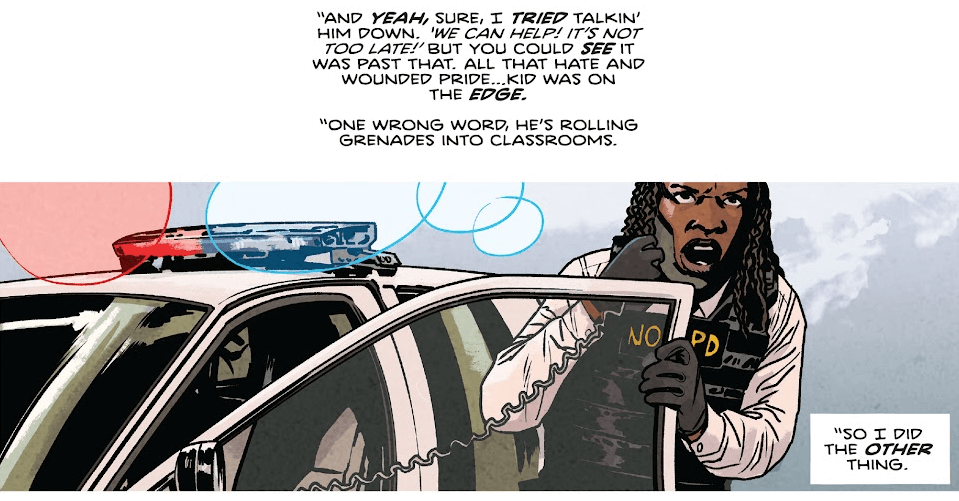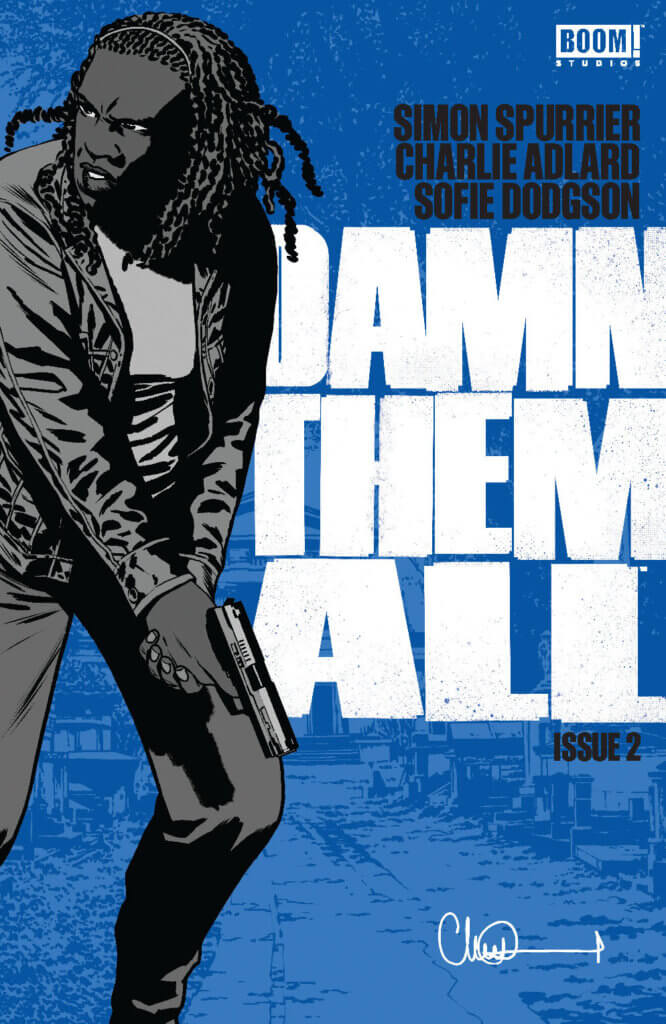Content warning: This review discusses suicide, gun violence, police violence, and school shootings.
Damn Them All #2 opens with a bit of backstory. It’s to explain Dora—the American police detective who appeared in issue #1 —and her entanglement with Alfie Hawthorne, the uncle of our protagonist, El.
Damn Them All #2
Charlie Adlard (Artist), Jim Campbell (Letterer), Shayne Hanna Cui (Colorist), Sofie Dodgeson (Colorist), Simon Spurrier (Writer),
Boom! Studios
November 30, 2022
This backstory is intriguing, but more importantly, it is difficult. There’s a lot of complexity and nuance crammed into the issue’s first few pages: Dora is a Black woman, an American cop, and she oversaw the police response to a school shooting that ended with the gunman dead by suicide. It’s a brutal opener, one that left me feeling uncomfortable. I think it should; there is little to be gained by a story like this that makes me feel that all is right and just in the world. But even so, I find myself stewing over it, trying to pick it apart.
The rest of the issue is, much like the first, intriguing. It still hasn’t quite grabbed me, maybe because I’m so fixated on the opening. Dora’s guilt haunts her literally, as the ghost of the young man who planned to shoot up his school appears before her every night. She’s also placed on suspension—or “compassionate leave,” as her department calls it—after protests, which she identifies as stemming from racism. She’s right, or as right as a fictional character can be about a fictional scenario, but there’s something uncomfortable in this story for me.
I don’t necessarily mean “uncomfortable” as in “bad.” I mean it literally; the story makes me a little squirmy as I try to pick apart my feelings about police violence from the truth of racism and the more specific problem of misogynoir, compounded by the fact that Dora’s actions definitely prevented a school shooting. Does that justify suicide baiting? How much is a single life worth against a potential tragedy? How about when the structural issue of police violence comes into play? How about when the perpetrator of that police violence is a Black woman?
The questions are interesting, but then I have to go a step further: to my knowledge, no Black are people working on the core team of this series. It’s not that that makes this story off-limits, only that I have to weigh my complicated feelings against that. Many things can be true simultaneously: that police brutality exists, that misogynoir exists, and that preventing a school shooting is good. It’s also true that I’m not sure this team has the lived experience to do justice to a story like this, in which Blackness intersects with police violence. My complicated feelings about Dora, the sole Black woman in Damn Them All‘s admittedly small cast, remain.
The tricky thing is that this flashback, which takes up only three of the issue’s 26 pages, is not the focus. It tells us how Dora became part of the occult world El inhabits—haunted both literally and figuratively by the death of the potential school shooter, she bumps into El’s late uncle Alfie, who gives her some hypnotherapy. The two hook up, bringing Dora further into Alfie’s life, which brings us to the real point of this backstory: that Dora feels she owes him, and that she suspects his death from a heart condition isn’t what it seems.
The issue carries on, suggesting a connection between Alfie and the problem of the demons trapped in coins we learned of in the last issue. What of El? Well, not much. She is there to be grumpy and the living anchor for the story now that Alfie’s dead. My complaints about the first issue, unfortunately, stand. Alfie works too well as a John Constantine-like figure without really adding much that’s new, El doesn’t have much of a personality beyond “grumpy and begrudgingly involved in this conflict,” and while I’m intrigued by the story, I’m not attached.
Though the story gives me some pause, Simon Spurrier’s sharp dialogue, Charlie Adlard’s stark linework, and Sofie Dodgson and Shayne Hanna Cui’s colors still impress. Spurrier has an ear for lively speech, emphasized by and balanced with Campbell’s lettering. Much like in John Constantine: Hellblazer, Spurrier’s dialogue contains asides and murmurs that might be difficult to parse in speech bubbles. Jim Campbell emphasizes what needs to be emphasized and signals to the reader what’s said quietly using smaller and lighter text. It’s easy to get into the rhythm of the dialogue this way; I don’t feel like I need to read and re-read the same bubble to get the point, which is tricky with dialect- and colorful-swear-heavy writing like Spurrier’s. Spurrier knows when to deliver punchy language, and Campbell knows how to make it legible.
Adlard’s artwork continues to draw the reader into the dark and noir-infused world of the comic, making heavy use of stark, thick lines to cast even the brightest scenes in shadow. This sometimes works exceptionally well—especially in daylight scenes, where the dark shadows keep the tone consistent—but sometimes obscures details without adding much in the way of mood. While Adlard’s style is well-suited to the tone, I’d like to see a little more diversity in how things look from scene to scene.
Dodgson and Cui’s colors remain consistently strong in this issue, brightening the darker scenes with colors that liven up the darkness without losing the moodiness. Once again, the sparing use of chromatic aberration makes the demons that turn up all the more interesting and jarring. Though readers, unlike the characters, may not be vomiting or having mental breakdowns looking at these pages, there’s a fundamental wrongness to how they look, drawing from their classical inspirations but infused with new technology. It’s a perfect mirror to the story, as well, connecting the way things ought to be to the way they currently are.
But despite the successes, all I can think about is those opening three pages. They loom much larger in my mind than the rest of the story, which could be to the comic’s benefit if I felt better about praising it for making me uncomfortable in a thought-provoking way. But because the team, to my knowledge, is not Black, and because we have a Black woman enacting police violence, I’m stuck wondering whether this is good discomfort or bad. I suspect my feelings would be clearer if the issue were more about Dora’s backstory and the complexities of her identity intertwined with her actions as a cop and less about how that backstory brought her to Alfie. But this is what I have, and while I find it interesting, I’m not sure I’m ready to praise it for that just yet.
The unfortunate truth of Damn Them All, both issues so far, is that I really want it to be good, and it so far has failed to live up to that. If the series were to be canceled tomorrow, I would say, “Bummer,” and move on with my life. I want to be captivated. I want to find something that makes me excited to see it in my pull box every month. As it is, I see hints and tidbits that intrigue me, but the story seems so wrapped up in Alfie, a character who isn’t even present, that I can’t get into the people it’s meant to be about. And the incisive (though sometimes clumsy) social commentary of Spurrier’s run on John Constantine: Hellblazer feels muddled and inconclusive here.
Maybe it’ll pick up. I sincerely hope it does. There’s talent in this team and an intriguing premise, but it feels buried beneath a bit of a mess.


